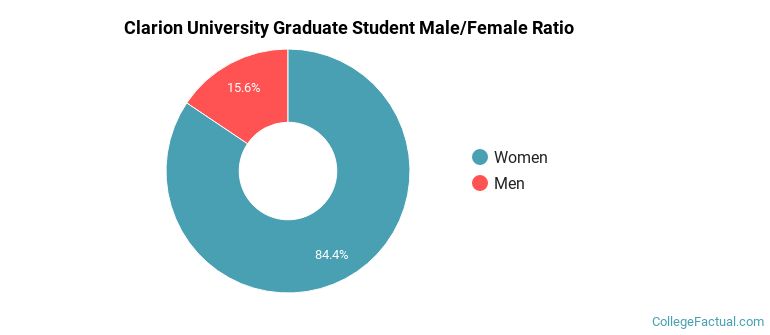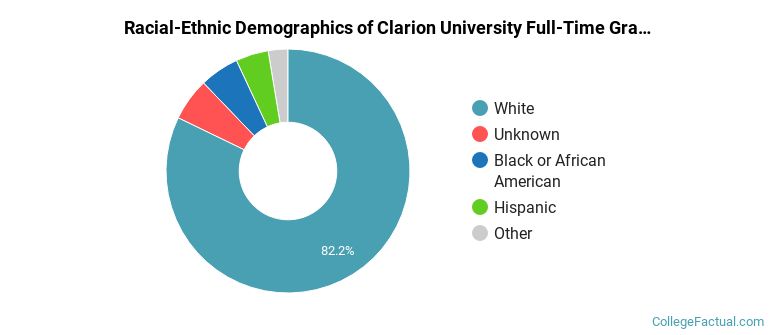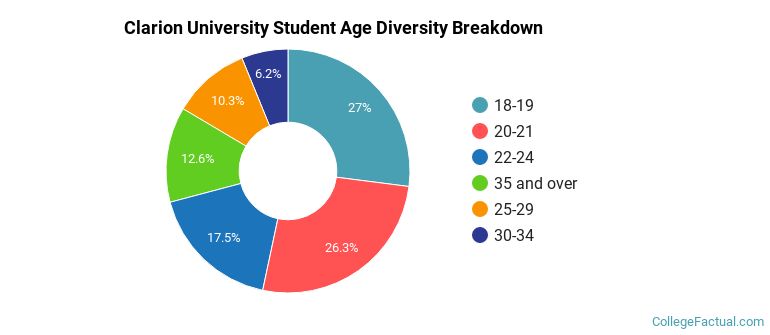 by our College Data Analytics Team
by our College Data Analytics TeamClarion University total enrollment is approximately 4,465 students. 2,889 are undergraduates and 208 are graduate students.
Male/Female Breakdown of Undergraduates
The full-time Clarion University undergraduate population is made up of 67% women, and 33% men.

For the gender breakdown for all students, go here.
Clarion University Racial/Ethnic Breakdown of Undergraduates

| Race/Ethnicity | Number |
|---|---|
| White | 2,418 |
| Black or African American | 248 |
| Hispanic | 83 |
| Multi-Ethnic | 52 |
| Unknown | 42 |
| Asian | 27 |
| International | 9 |
| Native Hawaiian or Pacific Islander | 4 |
See racial/ethnic breakdown for all students.
Male/Female Breakdown of Graduate Students
About 88% of full-time grad students are women, and 13% men.

For the gender breakdown for all students, go here.
Clarion University Racial-Ethnic Breakdown of Graduate Students

| Race/Ethnicity | Number |
|---|---|
| White | 167 |
| Black or African American | 12 |
| Unknown | 12 |
| Hispanic | 10 |
| Multi-Ethnic | 4 |
| Asian | 2 |
| International | 1 |
| Native Hawaiian or Pacific Islander | 0 |
See racial/ethnic breakdown for all students.

| Race/Ethnicity | Number |
|---|---|
| White | 3,638 |
| Black or African American | 334 |
| Unknown | 190 |
| Hispanic | 150 |
| Multi-Ethnic | 78 |
| Asian | 46 |
| International | 16 |
| Native Hawaiian or Pacific Islander | 5 |

There are approximately 3,171 female students and 1,294 male students at Clarion University.
Clarion University ranks 1,403 out of 2,183 when it comes to geographic diversity.
8.51% of Clarion University students come from out of state, and 0.11% come from out of the country.

The undergraduate student body is split among 20 states (may include Washington D.C.). Click on the map for more detail.

| State | Amount |
|---|---|
| Pennsylvania | 860 |
| Ohio | 20 |
| Maryland | 19 |
| Virginia | 9 |
| New York | 7 |
Students from 8 countries are represented at this school, with the majority of the international students coming from Saudi Arabia, Canada, and Nigeria.
Learn more about international students at Clarion University.
A traditional college student is defined as being between the ages of 18-21. At Clarion University, 52.63% of students fall into that category, compared to the national average of 60%.

| Student Age Group | Amount |
|---|---|
| 18-19 | 1,394 |
| 20-21 | 1,356 |
| 22-24 | 905 |
| 35 and over | 652 |
| 25-29 | 532 |
| 30-34 | 318 |
| Under 18 | 0 |
Footnotes
*The racial-ethnic minorities count is calculated by taking the total number of students and subtracting white students, international students, and students whose race/ethnicity was unknown. This number is then divided by the total number of students at the school to obtain the racial-ethnic minorities percentage.
References
Department of Homeland Security Citizenship and Immigration Services
Image Credit: By Clarion, Pennsylvania under License
Read College Factual's Diversity Ranking Methodology.